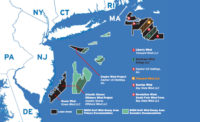Plans to build the nation’s largest solar energy farm took a major step toward reality in late December with the release of the federal Bureau of Land Management’s final environmental impact statement for the proposed $1-billion Gemini Solar Project in Nevada.
Quinbrook Infrastructure Partners, in collaboration with California-based Arevia Power, will build the 690-MW project on a 7,100-acre federally owned site 33 miles from Las Vegas. The EIS describes BLM’s “hybrid” preferred alternative as combining “traditional development methods” for ground-mounted photovoltaic panels on 2,500 acres, with remaining solar array areas mowed to leave vegetation and natural land contours in place.
Coupled with a 380-MW alternative current battery storage system, the solar farm will serve customers of NV Energy, Nevada’s largest energy services provider, under a 25-year contract.
Originally stalled by the Obama administration over issues such as threats to habitat of the desert tortoise, a federally listed threatened species, the Gemini project found new life under the Trump administration Interior Dept., which has been more supportive of energy development on public land.
In a statement issued last June when the EIS comment period began, Tim Smith, manager of the BLM Southern Nevada District, said the Gemini project “would represent a significant increase in renewable energy capacity for Nevada and the West.”
Conservation groups are concerned that BLM’s environmental analysis falls short in mitigating potential impacts. Defenders of Wildlife representative Jeff Aardahl said that BLM’s assertion that maintaining vegetation and soils in the solar facility’s mowed area would provide sufficient habitat for tortoises is “untested” and “inappropriate over such a large project area.”
Release of the final environmental review comes just weeks after Nevada’s Public Utilities Commission approved Gemini and two smaller solar projects to be located on Native American reservations near Las Vegas. BLM approval could come soon after the 30-day EIS protest period ends Jan. 27, allowing construction to get underway later this year. NV Energy plans for Gemini and the other facilities to begin operation in early 2024.
The largest currently operating U.S. solar farm is the 579-MW Solar Star in California, which came on line in 2015. But the world’s largest is the Pavagada Solar Park in India, which activated its entire operation on Dec. 17, with generation capacity of 2,050 MW. The facility covers about 13,000 acres in the Tumakuru district of Karnataka.





Post a comment to this article
Report Abusive Comment